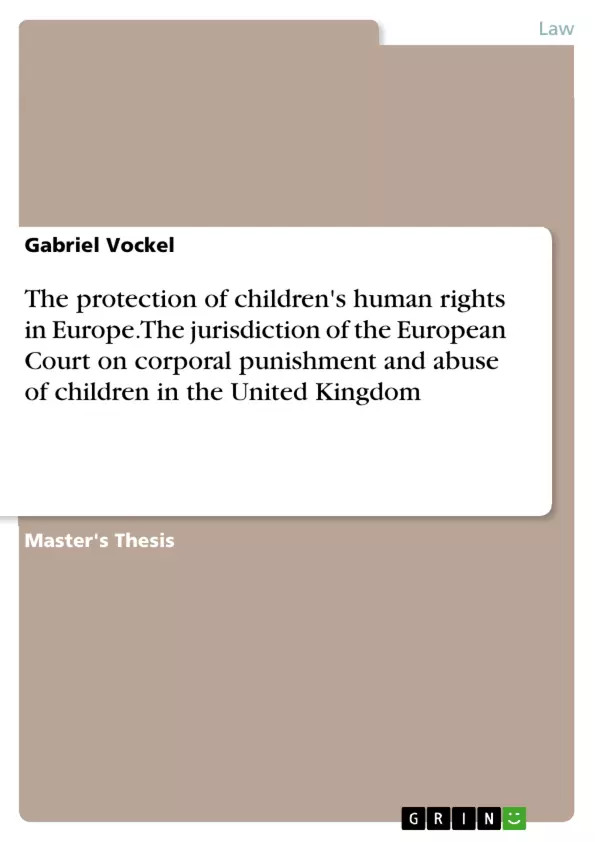The analysis undertaken in this dissertation gives attention to three core foci of examination. The first two are international legal documents used in the protection of human rights: The United Nations Convention on the Rights of the Child (CRC) from 1989 and the European Convention on Human Rights and Fundamental Freedoms (ECHR) from 1950. The third focal point consists of an investigation into a specific area of jurisprudence of the European Court of Human Rights (the Court) regarding the protection of human rights of children: the phenomenon of the corporal punishment and abuse of children in the UK. This selection of verdicts of the European Court aims at portraying how the ECHR impacts on the child’s human rights in practice and how well the work of the European Court reflects the values enshrined in the CRC and also gain an understanding of how the two conventional systems might impact on the other. The third chapter investigates verdicts of the Court that have dealt with cases that derive from institutional settings (judicial corporal punishment and punishment in public schools). The fourth chapter will observe private settings, where cases of corporally punished children relate to the private sphere (e.g. punishment through parents). Beside, it is intended to give a short outlook on two selected cases where a matter of more general abuse of children was under judicial scrutiny. The dissertation concludes that both the CRC and the ECHR are characterised by a number of more or less serious flaws and drawbacks in relation to the protection of children’s human rights. The narrow textual scope of the ECHR and the significant weaknesses of the CRC regarding its implementation mechanism are two prominent examples. The paper suggests that in Europe, the trend of maximising the potential of the European Convention by combining the widely accepted, detailed standards on children’s rights set out in the UN Convention with the highly successful and influential system of individual petition and implementation should find its continuation and be strengthened even further.
Inhaltsverzeichnis (Table of Contents)
- Abstract
- Introduction
- Chapter 1:
- Analysis of the Convention on the Rights of the Child
- Core stipulations and values of the CRC
- The implementations mechanism of the CRC
- Chapter 2:
- Analysis of the European Convention on Human Rights and Fundamental Freedoms
- The implementation mechanism of the ECHR
- Limitations of the ECHR regarding the protection of children's human rights
- Chapter 3:
- The verdicts of the European Court of Human Rights regarding corporal punishment of children by third parties
- Judicial corporal punishment
- Corporal punishment in other institutional settings
- Chapter 4:
- Verdicts of the European Court of Human Rights regarding corporal punishment and abuse in the private domain and the reflection of the CRC
- Corporal abuse in the private sphere more generally
- The reflection of the CRC in the public discourse surrounding the corporal punishment and abuse of children
- Conclusions
- Bibliography
Zielsetzung und Themenschwerpunkte (Objectives and Key Themes)
This dissertation aims to examine the impact of the UN Convention on the Rights of the Child (CRC) and the European Convention on Human Rights and Fundamental Freedoms (ECHR) on the protection of children's human rights, specifically focusing on the phenomenon of corporal punishment and abuse of children in the UK. The analysis investigates how the European Court of Human Rights (the Court) interprets and applies these conventions in its rulings on such cases. The dissertation also seeks to uncover the strengths and weaknesses of both conventions in protecting children's rights and suggests ways to improve their effectiveness.
- The application and interpretation of the CRC and ECHR in the context of children's human rights protection
- The effectiveness of the European Court of Human Rights in upholding children's rights
- The impact of the CRC and ECHR on legislative and judicial practice in the UK
- The strengths and weaknesses of both conventions in safeguarding children's human rights
- Recommendations for improving the implementation and effectiveness of the CRC and ECHR in protecting children's rights
Zusammenfassung der Kapitel (Chapter Summaries)
Chapter 1 focuses on the UN Convention on the Rights of the Child (CRC), outlining its core stipulations, values, and implementation mechanisms. Chapter 2 delves into the European Convention on Human Rights and Fundamental Freedoms (ECHR), exploring its implementation framework and limitations in protecting children's human rights. Chapter 3 examines verdicts of the European Court of Human Rights related to corporal punishment of children by third parties, specifically focusing on judicial corporal punishment and corporal punishment in institutional settings. Chapter 4 further analyzes verdicts of the European Court concerning corporal punishment and abuse in the private domain, including cases of corporal abuse in the family sphere. This chapter also discusses how the CRC influences public discourse on corporal punishment and abuse of children.
Schlüsselwörter (Keywords)
The key themes and concepts addressed in this dissertation include the protection of children's human rights, the UN Convention on the Rights of the Child (CRC), the European Convention on Human Rights and Fundamental Freedoms (ECHR), the European Court of Human Rights, corporal punishment, child abuse, UK legislation, international human rights law, implementation mechanisms, and the role of the European Court in interpreting and applying international legal norms.
- Quote paper
- Master of Arts in Diplomacy, Law and Global Change Gabriel Vockel (Author), 2005, The protection of children's human rights in Europe. The jurisdiction of the European Court on corporal punishment and abuse of children in the United Kingdom, Munich, GRIN Verlag, https://www.grin.com/document/66210



